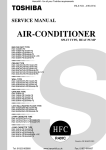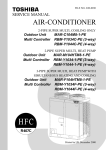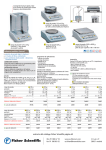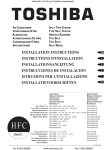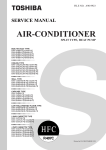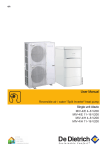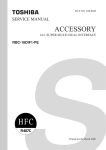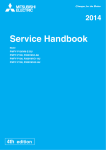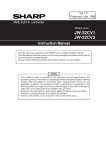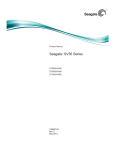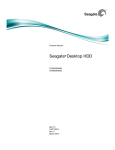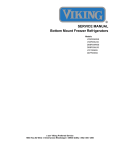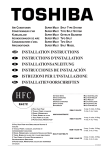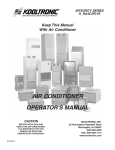Download Installation Outdoor unit
Transcript
Contents Contents Introduction .......................................................................................................................... 4 Installation ............................................................................................................................ 8 Trial run .............................................................................................................................. 36 Troubleshooting ................................................................................................................. 43 Environmental .................................................................................................................... 47 Passer à la page 49 pour lire le manuel d’installation en français. Die deutsche Installationsanleitung finden Sie auf Seite 95. Por favor, vaya a la página 141 para seguir las instrucciones del manual de instalacíon en lengua española. Il manuale d’installazione italiano è a pagina 187. Zie bladzijde 233 voor de Nederlandse Installatievoorschriften. See page 279 for the Portuguese Installation Instructions. See page 325 for the Greek Installation Instructions. 3 Introduction Contents Precautions .......................................................................................................................... 5 Operating conditions ............................................................................................................ 6 Metric/Imperial pipe conversion ........................................................................................... 6 Components ......................................................................................................................... 6 4 Introduction Precautions Please read these instructions carefully before starting the installation. This equipment should only be installed by suitably trained operatives. In all cases ensure safe working practice: Observe precautions for persons in the vicinity of the works. Ensure that all local, national and international regulations are satisfied. Check that the electrical specifications of the unit meet the requirements of the site. Carefully unpack the equipment, check for damage or shortages. Please report any damage immediately. These units comply with EU Directives: 73/23/EEC (Low Voltage Directive), 89/336/EEC (Electromagnetic Compatibility) and 97/23/EC (Pressure Equipment Directive). Accordingly, they are designated for use in commercial and industrial environments. Avoid installation in the following locations: Where there is danger of flammable gas leakages. Where there are high concentrations of oil. Where the atmosphere contains an excess of salt (as in coastal areas). The air conditioner is prone to failure when used under this condition unless special maintenance is provided. Where the airflow from the outdoor unit may cause annoyance. Where the operating noise of the outdoor unit may cause annoyance. Where the foundation is not strong enough to fully withstand the weight of the outdoor unit. Where the water drainage may cause a nuisance or a hazard when frozen. Where strong winds may blow against the air outlet of the outdoor unit. Precautions for R407C outdoor units R407C outdoor units use synthetic oils which are extremely hygroscopic. Therefore ensure that the refrigerant system is NEVER exposed to air or any form of moisture. Mineral oils are unsuitable for use in these units and may lead to premature system failure. Use only equipment which is suitable for use with R407C. Never use equipment which has been used with R22. R407C should only be charged from the service cylinder in the liquid phase. It is advisable to use a gauge manifold set equipped with a liquid sight glass fitted in the centre (entry) port. 5 Introduction Operating conditions OUTDOOR TEMPERATURE ROOM TEMPERATURE ROOM HUMIDITY -5 ~ 43°C COOLING -15 ~ 21°C HEATING 18 ~ 32°C COOLING 15 ~ 29°C HEATING <80% COOLING Metric/Imperial pipe conversion Diameter (mm) 6.4 9.5 12.7 15.9 19.0 22.0 28.6 34.9 41.3 54.1 Nominal diameter (inch) 1/4 3/8 1/2 5/8 3/4 7/8 1-1/8 1-3/8 1-5/8 2-1/8 Note: 1.0 MPa G = 10.2 kgf/cm2 G Components - 3 pipe system 1. Outdoor unit Model name Inverter unit MAR-F105HTM8-PE 10 HP 2. Multi controllers Model name No. of indoor units connectable RBM-Y1034F-PE 3 RBM-Y1044F-PE 4 3. Interface control kit Model name Requirement RBC-16DIF1-PE 3 or 4 multi controllers used on a system Combination of multi controllers, indoor units and interface kits No. of indoor units No. of 3-way multi controllers 1-8 1-2 multi controllers 9 3 0 1 10 2 1 1 11 1 2 1 12 0 3 1 13 3 1 2 14 2 2 2 15 1 3 2 16 0 4 2 6 No. of 4-way multi controllers No. of interface kits 0 Introduction Components 4. Indoor units Type Appearance Model name Capacity code on multi controller Cassette (4-way) RAV-164UH-PE RAV-264UH-PE RAV-364UH-PE RAV-464UH-PE 4 6 8 10 Cassette (2-way) RAV-104TUH-1-PE RAV-134TUH-1-PE RAV-164TUH-1-PE 2 3 4 RAV-104SBH-PE 2 RAV-164BH-PE RAV-264BH-PE RAV-364BH-PE RAV-464BH-PE 4 6 8 10 Ceiling Suspended RAV-134CH/CHR-PE RAV-164CH/CHR-PE RAV-264CH/CHR-PE RAV-364CH/CHR-PE RAV-464CH/CHR-PE 3 4 6 8 10 High Wall RAV-105KH-E RAV-135KH-E RAV-165KH-E RAV-265KH-E 2 3 4 6 Built-In Vertical RAV-104NH-PE RAV-134NH-PE RAV-164NH-PE RAV-264NH-PE 2 3 4 6 Floor Mounted RAV-164SH/SHR-PE RAV-264SH/SHR-PE 4 6 Built-In Horizontal 7 Installation Contents Outdoor unit Transportation of the outdoor unit ........................................................................................ 9 Installation of outdoor unit .................................................................................................. 10 Dimensional drawings outdoor unit .................................................................................... 11 Multiple installation on the rooftop ..................................................................................... 12 Multi controller Installation .......................................................................................................................... 14 Interface kit Installation .......................................................................................................................... 16 Piping Connecting refrigerant pipes .............................................................................................. 17 T-piece connections ........................................................................................................... 19 Connection to outdoor unit ................................................................................................. 20 Permissible length and head .............................................................................................. 22 Airtight test ......................................................................................................................... 26 Leak position check/air purge ............................................................................................ 27 Adding the refrigerant/charging the system ....................................................................... 28 Calculating the additional refrigerant required ................................................................... 29 Heat insulation ................................................................................................................... 30 Electrical wiring General/wiring system overview ........................................................................................ 31 Connecting the power source cable and control cable ...................................................... 32 Wiring between units .......................................................................................................... 33 8 Installation Outdoor unit Transportation of the outdoor unit Fork Lift • Front Access – insert the forks into the slots on the fixing legs. • Side Access – see diagram. Front Access Side Access Fork lift/hand truck Fork lift Fixing leg Crane • Check the suitability of the lifting rope (see table). • Secure lifting rope through transportation slot. • Protect the unit where rope contact could scratch or deform it. Protection Model Number Weight MAR-F105HTM8-PE 285 kg Rope Protection Transportation slots 9 Installation Outdoor unit Installation of outdoor unit 1. ≥ 20 mm ≥ 20 mm Align the outdoor units at intervals of 20 mm or more. Fix the outdoor units with M12 anchor bolts (4 positions per unit). 20 mm Anchor bolt with 20 mm length is suitable. M12 anchor bolt, 4 positions per unit • Anchor bolt pitch is as shown in the following figure. ≥ 310 mm 700 mm ≥ 310 mm 700 mm 755 mm 700 mm 15 x 20 mm slot When routing the refrigerant piping through the base, the fixing height of the base (two-divided foundations) must be 500 mm or more. ≥ 500 mm 2. Refrigerant piping 3. Correct foundation mounts for supporting the outdoor unit. ✖✔ 10 Installation Outdoor unit Dimensional drawings 4-15 x 20 (Slot) 90 Grounding part of bottom plate Fixing bolt positions 755 790 630 Fixing bolt pitch 90 700 990 Grounding part of bottom plate Foundation dimensions 750 110 90 1700 1582 700 601 88 Knock outs on both sides of unit 568 4-60 x 150 slot (for transport) 500 3-Ø20 cable gland knock outs Slot pitch Details of piping connections Refrigerant pipe connecting port (Gas suction side) braze connection (Ø28.6) Refrigerant pipe connecting port (Liquid side) flare connection (Ø15.9) 315 275 Refrigerant pipe connecting port (gas discharge side) flare connection (Ø19.0) 68 60 114 All dimensions in mm 11 Installation Outdoor unit Multiple installation on the rooftop If the outer wall is higher than the outdoor unit ≥ 600 ≥ 300 If a hole can be made in the wall: (Front side) ≥ 20 ≥ 20 ≥ 20 ≥ 20 Discharge duct HD ≥ 10 1. Vs ≥ 1000 h H 2. Set an aperture ratio so that suction air volume Vs from the hole becomes 1.5 m/s or less Height of discharge duct: HD = H - h If a hole cannot be made: ≥ 600 ≥ 300 Hole in wall (Front side) ≥ 20 ≥ 20 ≥ 20 ≥ 20 Discharge duct HD ≥ 10 Set a base with 500 to 1000 mm height Height of discharge duct: HD = H - h h H 1. 2. Vs Note: All dimensions are in mm Base 500 – 1000 12 Installation Outdoor unit If the outer wall is lower than the outdoor unit ≥ 500 ≥ 300 1-line installation (Front side) ≥ 10 ≥ 20 ≥ 20 ≥ 20 ≤ 800 ≥ 20 ≥ 600 * (≥ 1000) ≥ 300 2-parallel lines installation ≥ 300 (Front side) ≥10 ≥ 20 ≥ 20 ≥ 20 ≤ 800 ≥ 20 ≥ 600 * (≥ 1000) ≥ 300 3-parallel lines installation ≥ 500 ≥ 600 (Front side) (Front side) ≥ 10 ≥ 20 ≥ 20 ≥ 20 ≤ 800 ≥ 20 * When refrigerant piping is routed from the front of the unit, distance between outdoor unit and piping must be 500 mm or more (for service access). ≥ 500 ≥ 500 Note: All dimensions are in mm Piping Piping 13 Installation Multi Controller Precautions Avoid installing the multi controller in the following locations: Where rain water may penetrate the unit. Where the weight of the unit cannot be supported. Where it is not level. Where high temperature under the ceiling or high temperature atmosphere may be produced. Where there is equipment that generates high frequencies. Where it is near devices or wiring which may give off electromagnetic interference. The base of the unit will reach temperatures of approximately 50°C. Do not place heat-sensitive objects close to the base of the unit. Installation and service space Always locate the unit in such a location that the electrical panel can be removed easily. This is very important for trial tests and service. Electric parts box 450 mm x 450 mm access panel Handle the multi controller with care. ✔ Do not drop the unit as this could damage components inside. 14 20 mm or more Indoor unit connection side 500 mm or more 500 mm or more Outdoor unit connection side 500 mm or more Electric parts box 50 mm or more 100 mm or more The amount of space that is required for the service area is 450 mm x 450 mm. Access panel ✖ ✖ Installation Multi Controller Installation Installing ø 10 mm hanging bolts (4 pieces) • Install the hanging bolts at intervals shown in the following figure. • Use the ø 10 mm hanging bolts (to be locally procured). Ceiling preparation: The actual procedure differs according to the structure. Consult your builder or whoever was responsible for the interior of the house/building. 1. Remove part of the suspended ceiling: In order to ensure that the ceiling is kept perfectly horizontal and to prevent the ceiling from vibrating, the ceiling framework must be reinforced. 2. Cut and remove part of the ceiling framework. 3. Reinforce the ends of the ceiling framework where sections have been removed. • Some piping and wiring connections must be made in the ceiling after the unit has been suspended. After selecting where the unit will be installed decide on the direction of the piping and electrical connections. How to install the hanging bolts Installation on a newly installed concrete slab: Use insert brackets or foundation bolts for the installation. Reinforcing bar Knife-shaped bracket Sliding bracket Foundation bolt (Foundation bolt for hanging the piping) Installation on an existing concrete slab: Use hole-in anchors, hole-in plugs or hole-in bolts for the installation. Suspension Refer to the external view for the position measurement of the hanging bolts and the external measurements. Hanging bolt • Pick up the multi controller after matching with hanging bolts. 1. Hang the notch hole of the back part into the hanging bolt. 2. Fix the slot of the front part onto the hanging bolt. Nut (up side) Washer (up side) Body • Tighten the nut firmly, and fix the unit in place. • Use a hanging bolt with a diameter of 10 mm (local procurement). • After hanging the main unit ensure that it is level then proceed to make the refrigerant and electrical connections. Washer (down side) Nut (down side) 15 Installation Multi Controller Model A B C D E F RBM-Y1034F-PE 460 300 - 90 - 90 RBM-Y1044F-PE 530 370 90 90 90 90 All dimensions are in mm 2 notches for hanging bolts (12 x 21) 2 slots for hanging bolts (12 x 52) Electric parts box 80 50 Connection (brazing) Liquid side ø 15.9 300 A C D 90 55 E F 90 55 300 3-pipe: RBM-Y1034F/Y1044F-PE Refrigerant pipe connection (brazing) Liquid side ø 12.7 Wiring knockouts 6 x ø 20 110 Refrigerant pipe connection (brazing) Gas side ø 19 Refrigerant pipe connection (brazing) Delivery gas side ø 19 Refrigerant pipe connection (brazing) Suction gas side ø 28.6 Interface kit Precautions Avoid installation in the following locations: Where there is a danger of flammable gas leakage. Where there is a danger of water coming in contact with the dual interface. Where the mounting surface is flammable. Installation and service space • For internal use only. • Ensure that there is sufficient space around the dual interface for installation and servicing. 16 Installation Piping WARNING! During installation - if the refrigerant gas leaks, ventilate the room. After installation - check for gas leakages. If refrigerant gas comes into contact with fire - noxious gas may result! Connecting refrigerant pipes 1. To access the refrigerant piping connections and electrical wiring terminals, remove the 7 x M5 securing bolts in the front panel. To remove the panel, lift it up and away from its hanging tabs - see diagram. 2. The refrigerant pipes can be routed forwards, downwards or sideways. 3. If the pipes are routed forwards, make sure they exit through the piping/wiring panel - (remove knock out section) and allow at least 500 mm between the outdoor unit and the main pipe connecting it to the indoor unit. This is for servicing access. (Replacing the compressor, for example, requires a space of at least 500 mm.) Front panel ≥ If the pipes are routed downwards, remove the knock out section in the baseplate of the outdoor unit. This will enable access. They can then be connected to the left or right, or the rear side. 50 0 Piping/wiring panel 4. Pipes routed forward Pipes routed downwards Notes: 1. When brazing, use nitrogen. This prevents internal oxidisation of the pipes. 2. Always use clean new pipe, and ensure it is not contaminated by water or dust. Piping material: seamless, deoxidised copper piping for air conditioning (refrigeration quality tube). 3. Always use a double spanner on the flare nut - and tighten to the specified torque (see table). Note: All dimensions in mm Connecting pipe outer dia. (mm) Tightening torque (Nm) Re-tightening torque (Nm) Ø6.4 11.8 (1.2 kgf m) 13.7 (1.4 kgf m) Ø9.5 24.5 (2.5 kgf m) 29.4 (3.0 kgf m) Ø12.7 49.0 (5.0 kgf m) 53.9 (5.5 kgf m) Ø15.9 78.4 (8.0 kgf m) 98.0 (10.0 kgf m) Ø19.0 98.0 (10.0 kgf m) 117.7 (12.0 kgf m) Gas discharge valve position Liquid pipe valve position Gas suction valve position 17 Installation Piping Materials and sizes Materials and pipes required for connection between the indoor units, multi controllers and outdoor units are shown below: Multi controller Outdoor unit Pipe Main pipes Main pipes outdoor unit to outdoor unit to multi controller header Sub pipes header to multi controller Multi controller connections 1 unit MAR-F105HTM8-PE Suction gas Discharge gas Liquid Ø28.6 Ø19.1 Ø15.9 - - Ø28.6 Ø19.1 Ø15.9 2-4 units MAR-F105HTM8-PE Suction gas Discharge gas Liquid - Ø28.6 Ø19.1 Ø15.9 Ø19.1 Ø15.9 Ø12.7 Ø28.6 Ø19.1 Ø15.9 Gas Indoor unit* 10 Branch pipe sizes Ø12.7 Multi controller pipe sizes Ø19.1 Liquid 13 * Example: Indoor unit RAV-264CH-PE = 26 18 16 26 36 Ø15.9 Ø19.1 46 10 Ø6.4 Ø12.7 13 16 26 Ø9.5 36 46 Installation Piping T-piece connections • The main T-piece should be equal dimensions in all three positions, for example 12.7 x 12.7 x 12.7 mm. • The sub T-pieces should be a reducing type, see diagram below. Outdoor unit Suction gas MAR-F105HTM8-PE Discharge gas Liquid ØA ØB ØA ØB ØA ØB 28.6 19.1 19.1 15.9 15.9 12.7 Note: There must be at least 500 mm of straight pipe before any T-piece, this is to ensure equal distribution. Header design - 3-way Header design - 4-way ØB ØB 500 mm ØA ØA Equal T-piece Equal T-piece ØB ØB ØA Reducing T-piece ØA Reducing T-pieces ØB ØA ØA ØB Reducer ØB 500 mm 500 mm 500 mm • Keep the T-piece horizontal to the multi controller, if necessary bending the sub piping. • Secure the T-piece to a wall or joist in the ceiling. • Ensure a minimum of 500 mm of straight piping before any T-piece. This is to ensure equal distribution. • Ensure correct pipe dimensions are used, between outdoor unit, T-pieces, multi controller and indoor units. • As shown in the above tables, ensure the size of the main gas pipe between the T-piece and the outdoor unit must be the next size up compared with the pipe size between the T-piece and the multi controllers. • Ensure any unused circuits on the multi controllers are sealed with brazed cap. Horizontal ✔ ✖ Horizontal Inclined ✔ Inclined ✖ Main pipe from the outdoor unit Sub pipes to the multi controllers 500 mm or more 19 Installation Piping Connection to outdoor unit • • • • • The refrigerant pipes are connected inside the outdoor unit. The pipes can be routed forwards, downward or sideways. Do not use a liquid sight glass or incorporate an oil trap in vertical pipework. A dryer is incorporated into the piping of the outdoor unit. Cleanliness is essential - keep the piping securely sealed at all times throughout the installation. Suction gas valve brazing Liquid pipe valve position Gas discharge valve position Gas suction valve position When brazing, position a wet cloth around the suction valve to ensure the temperature remains below 120°C otherwise equipment damage may result. Pipework routed forwards • • • If pipework is routed forwards ensure they exit through the piping and wiring panel (remove knock out section first) Cut the connecting section at the end of the pipe with a pipe cutter. Allow at least 500 mm between the outdoor unit and the main pipe connecting it to the indoor unit. This is for servicing access. (Replacing the compressor, for example, requires a space of at least 500 mm.) Suction valve Shaped pipe section Cut connecting end section 20 Installation Piping Pipework routed downwards • • • • If the pipes are routed downwards, remove the knock out section in the baseplate of the outdoor unit. This will enable access. They can then be connected to the left or right, or the rear side. De-braze or cut with a pipe cutter the connecting section above the flare. Braze connecting pipework to suction valve pipe. Ensure the suction valve is kept cool at all times. Suction valve Cut or debraze L-shaped pipe Braze connecting pipe Remove base plate knock out Pipework routed sideways • • • • If the pipes are routed sideways, remove the knock out section in the sideplate of the outdoor unit. This will enable access. De-braze or cut with a pipe cutter the connecting section above the flare. Braze connecting pipework to suction valve pipe. Ensure the suction valve is kept cool at all times. Suction valve Cut or debraze L-shaped pipe Braze connecting pipe Indoor unit pipework Connecting refrigeration pipes (outdoor/multi controller/indoor) • When brazing, position a wet cloth around the pipework between the brazed joint and multi controller to ensure the temperature remains below 120°C. Equipment damage to components within the multi controller may result if not protected. Indoor units Wet cloth position Braze positions Multi controller Outdoor unit Gas suction side Gas discharge side Liquid side 21 Installation Piping Permissible piping length and head The maximum piping length from L ≤ 120 m Equivalent length the outdoor unit to the indoor unit Actual length L ≤ 100 m The maximum height difference from the outdoor unit to When the outdoor unit is above H ≤ 50 m the multi controller or the indoor unit When the outdoor unit is below H ≤ 20 m One-Multi-Controller system Branch pipe Main pipe Indoor A Indoor B Multi controller 1 Indoor C Indoor D Outdoor unit Maximum piping lengths (actual) No. of multi controllers Main pipe Branch pipe Max. total pipe 1 3 m - 70 m 2 m - 30 m 100 m Permissible piping length H1 Maximum height difference between multi controller and indoor unit ≤ 15 m H2 Maximum height difference between indoor units ≤ 15 m ∆L Maximum piping difference between multi controller and indoor unit ≤ 10 m ∆L = longest pipe (L2) - shortest pipe (L1) Pipe size 22 Gas suction pipe ØA Liquid pipe ØA Gas discharge pipe ØA 28.6 15.9 19.1 Installation Piping Two-Multi-Controller system Main pipe Branch pipe Sub pipe Indoor A Multi controller 1 Indoor B Indoor C Indoor D Reducing T-piece Indoor E Outdoor unit Indoor F Multi controller 2 Indoor G Sub pipe Indoor H Maximum piping lengths (actual) No. of multi controllers 2 Main pipe Sub pipe Branch pipe Max. total pipe 2 m - 70 m 1 m - 15 m 2 m - 30 m 100 m Main pipe + longest sub pipe ≤ 70 m Permissible piping length H1 Maximum height difference between multi controller and indoor unit ≤ 15 m H2 Maximum height difference between indoor units ≤ 15 m ∆L Maximum piping difference between multi controller and indoor unit ≤ 10 m ∆K Maximum piping difference between sub pipes (K2 - K1) ≤ 10 m L = longest pipe - shortest pipe Pipe size Gas suction pipe ØA Liquid pipe ØA Gas discharge pipe ØA 28.6 15.9 19.1 19.1 12.7 15.9 23 Installation Piping Three-Multi-Controller system Main pipe (X) Main pipe (Y) Branch pipe Sub pipe Indoor A Indoor B Multi controller 1 Reducer Indoor C Indoor D T-piece Indoor E Sub pipe Outdoor unit Indoor F Multi controller 2 Indoor G Indoor H Reducing T-piece Indoor I Indoor J Multi controller 3 Main pipe (Z) Indoor K Indoor L Maximum piping lengths (actual) No. of multi controllers Main pipe (X+Y+Z) Sub pipe Branch pipe Max. total pipe 3 2 m - 70 m 2 m - 30 m 100 m 1 m - 15 m Main pipe + longest sub pipe ≤ 70 m Permissible piping length Pipe size H1 Maximum height difference between multi controller and indoor unit ≤ 15 m H2 Maximum height difference between indoor units ≤ 15 m ∆L Maximum piping difference between multi controller and indoor unit (L2 - L1) ≤ 10 m ∆K Maximum piping difference between sub pipes (K2 - K1) ≤ 10 m ∆M Maximum piping difference between main pipes Y and Z (M2 - M1) ≤ 10 m L = longest pipe - shortest pipe 24 Gas suction pipe ØA Liquid pipe ØA Gas discharge pipe ØA 28.6 15.9 19.1 19.1 12.7 15.9 Installation Piping Four-Multi-Controller system Branch pipe Main pipe (Y) Sub pipe Main pipe (X) Indoor A Multi controller 1 Indoor B Indoor C Indoor D Indoor E Multi controller 2 Indoor F Indoor G Indoor H T-piece Indoor I Outdoor unit Indoor J Multi controller 3 Indoor K Indoor L Reducing T-piece Indoor M Multi controller 4 Main pipe (Z) Indoor N Indoor O Indoor P Maximum piping lengths (actual) No. of multi controllers 4 Main pipe (X+Y+Z) Sub pipe Branch pipe Max. total pipe 2 m - 70 m 2 m - 30 m 100 m 1 m - 15 m Main pipe + longest sub pipe ≤ 70 m Pipe size Permissible piping length H1 Maximum height difference between multi controller and indoor unit ≤ 15 m H2 Maximum height difference between indoor units ≤ 15 m ∆L Maximum piping difference between multi controller and indoor unit (L2 - L1) ≤ 10 m ∆K Maximum piping difference between sub pipes (K2 - K1) ≤ 10 m ∆M Maximum piping difference between main pipes Y and Z (M2 - M1) ≤ 10 m Gas suction pipe ØA Liquid pipe ØA Gas discharge pipe ØA 28.6 15.9 19.1 19.1 12.7 15.9 L = longest pipe - shortest pipe 25 Installation Piping Airtight test Carry out an airtight test after the refrigerant piping is complete. For an airtight test, connect a nitrogen gas bottle as shown, and apply pressure (use oxygen-free nitrogen, OFN). The pressure test must be completed before supplying power to ensure that the multi controller PMVs (pulse modulating valves) are open. The test must be completed with the indoor units, multi controllers and outdoor unit connected. • • • Be sure to carry out the test from the service ports of the packed valves at the discharge gas, liquid and suction gas side. Keep all of the valves at discharge gas, liquid and suction gas sides fully closed. Nitrogen may enter the cycle of the outdoor unit. Therefore, retighten the valve rod before applying pressure. (For all valves.) For each refrigerant line, apply pressure gradually at the discharge gas, liquid and suction gas sides. Never use oxygen, or a flammable noxious gas. Low High pressure pressure gauge gauge Packed valve fully closed (gas suction side) Detailed drawing of packed valve Gauge manifold Inverter outdoor unit Brazed Service port at gas discharge side To manifold Service port Flare connection Copper pipe ø 6.4 Service port Service port at gas suction side Flare connection Packed valve fully closed (liquid side) Regulator Copper pipe ø 6.4 Nitrogen gas Service port at liquid side Packed valve fully closed (gas discharge side) To detect a large leakage Step 1: 0.3 MPa (3 kg/cm2 G) Apply pressure for 3 minutes or more Step 2: 1.5 MPa (15 kg/cm2 G) Apply pressure for 3 minutes or more To detect a fine leakage Step 3: 3.0 MPa (30 kg/cm2 G) Apply pressure for 24 hours • Check for a reduction in pressure. If there is no reduction in pressure this is acceptable. If there is a reduction in pressure check for a leakage. (Note: If there is a difference of ambient temp. between when the pressure was applied and 24 hours later, then pressure could change by approx. 0.01 MPa (0.1 kg/cm2 G) - so correct the pressure change. 26 Installation Piping Leak position check If a pressure drop is detected, check for leakage at connecting points. Locate the leakage by listening, feeling, using foaming agent, etc. - then rebraze or retighten. Air purge The air purge must be completed before supplying power to ensure the multi controller’s PMVs are open. Using a vacuum pump, complete an air purge. Never use refrigerant gas. • After the airtight test, discharge the nitrogen gas. • Connect a gauge manifold to the service port at discharge gas, liquid and suction gas sides, and connect a vacuum pump as shown. • Be sure to vacuum at discharge gas, liquid and suction gas sides. Detailed drawing of packed valve Packed valve fully closed (gas suction side) Inverter outdoor unit Low High pressure pressure gauge gauge Gauge manifold Brazed Service port at gas discharge side To manifold Service port Flare connection Service port Service port at gas suction side Flare connection Service port at liquid side Packed valve fully closed (liquid side) Vacuum pump Packed valve fully closed (gas discharge side) • Use a vacuum pump with high vacuum carry-over degree (-0.013 x 105 Pa; 0.750 mm Hg or less) and large displacement (40 l/min. or more). • Ensure to create a vacuum at -0.013 x 105 Pa (0.75 mm Hg) at the discharge gas, liquid and suction gas. • After the procedure has been completed, replace the vacuum pump with a refrigerant bottle and add the refrigerant if required. 27 Installation Piping Adding the refrigerant After the airtight test, replace the vacuum pump with a refrigerant bottle to charge the system. Calculating the additional refrigerant required The refrigerant amount at shipment does not include the refrigerant needed for the piping - so first calculate this amount, and then add it. Refrigerant charge amount shipped from the factory Outdoor unit model name MAR-F105HTM8-PE Charging amount (kg) 19.0 Maximum gas charge (kg) 36.3 The amount of additional refrigerant is calculated from the actual length of the liquid pipe. To calculate the additional refrigerant volume, refer to the diagram and follow the steps below: (i) The main pipe length is taken as the addition of pipes X, Y and Z. (ii) The sub pipe length is taken as the addition of the two longest of the four (if 4 multi controllers). (iii) The branch pipe lengths must be individually calculated using the 8 longest pipes. (iv) Do not attempt to add gas above the maximum shown in the table above. (v) For systems with one multi controller ignore the sub-pipe section within the additional gas charge calculation. (vi) When using three multi controllers, it is important that a reducer is used on the pipework for the third multi controller. Pipework before the reducer is classed as main piping and after as sub piping. Charging the system • Keeping the outdoor unit valve closed, charge the refrigerant from the service port on the liquid side. • If the specified amount of refrigerant cannot be charged - fully open all the outdoor unit’s valves, then perform the cooling operation with the valve at the gas side slightly closed. • If leaks cause a shortage of refrigerant - recover the refrigerant from the system, and recharge with new refrigerant to the total refrigerant charge. 28 Installation Piping Additional refrigerant One Multi Controller Indoor Outdoor M/C L3 L1 Two Multi Controllers Indoor Outdoor M/C Table 1 - Branch pipes L2 L1 L3 RAV-10* : 0.030 kg/m RAV-13* : 0.030 kg/m RAV-16* : 0.030 kg/m Three Multi Controllers RAV-26* : 0.045 kg/m Indoor RAV-46* : 0.045 kg/m M/C Outdoor Example: RAV-464CH-PE RAV-46* Y X RAV-36* : 0.045 kg/m L3 L2 Z Four Multi Controllers Indoor M/C Outdoor Y X Z L2 L1 = Main pipe (X + Y + Z) L2 = Sub pipe L3 = Branch pipe L3 Pipe MAR-F105 - main pipe L1 (X+Y+Z) (minus 2 m) 1st longest sub pipe L2 (minus 1 m) 2nd longest sub pipe L2 (minus 1 m) 1st longest branch pipe L3 (minus 2 m) 2nd longest branch pipe L3 (minus 2 m) 3rd longest branch pipe L3 (minus 2 m) 4th longest branch pipe L3 (minus 2 m) 5th longest branch pipe L3 (minus 2 m) 6th longest branch pipe L3 (minus 2 m) 7th longest branch pipe L3 (minus 2 m) 8th longest branch pipe L3 (minus 2 m) x x x x x x x x x x x Additional gas/metre Additional gas 0.19 kg/m = 0.125 kg/m = 0.125 kg/m = Refer to Table 1 = Refer to Table 1 = Refer to Table 1 = Refer to Table 1 = Refer to Table 1 = Refer to Table 1 = Refer to Table 1 = Refer to Table 1 = Total additional gas charge = kg 29 Installation Piping Heat insulation • Provide heat insulation on the refrigerant piping on both the liquid side and the gas side separately, and ensure that joints in the insulation are vapour-sealed. • Since the temperature of the piping on the gas side increases during heating operations, the heat insulating material used must be able to withstand temperatures of more than 120°C. Liquid pipe Gas pipe ✖ Thermal insulator Thermal insulator Gas pipe • Thermal insulator Liquid pipe ✔ Insulate the pipework as shown in the diagram below, slide insulation up to the insulation on the multi controller and seal joint with heat insulating tape. Heat insulating tape Pipe insulation butted together Brazed joint • 30 In the situation where high ceiling ambient temperatures are present thicker pipe insulation should be used. Installation Electrical wiring Precautions This guide should be read and utilised in conjunction with official published regulations and codes of practice, be they local, national or international. Each air conditioning system will have its own discrete power supply, with overload current protection. The electrical power will be supplied to the outdoor unit via the built-in isolator. The indoor units will derive their electrical power from the multi controller, and they in turn will derive their power from the outdoor unit. The interface kit will derive its electrical power from the outdoor unit. The circuit protection device will protect the supply cable against overcurrent. The circuit protection must be selected having due regard to the compressor starting current, such that the supply cables when sized correctly, are protected. The cable should be selected to match the nominal load of the system, in addition to the losses associated with corrections for length, temperature, impedance, etc. In accordance with local codes of practice. Please refer to the unit’s nameplate and the relevant technical specifications to determine the correct power supply. Distribution board Power supply wiring • Connect the power supply cables to the isolator on the outdoor unit. • Secure the power cables on the terminal contact firmly. Built-in isolator Super Multi outdoor unit • Do not allow the cables to come into contact with any valves or pipes. • Use the correct sized cable glands when connecting the power supply cables to the service panel. • The table below shows the supply requirements. Model Running current (A) Starting current (A) Power supply MAR-F105HTM8-PE 17.7 60 3 Ø 50 Hz 380/415 V 31 Installation Electrical wiring Connecting the power source cable and control cable Insert the power source cable and control cable after removing the knockout in the piping / wiring panel on the front or side of the outdoor unit. Knock out (x4) for control cable and power source cables Piping/wiring panel Power source cable • • Connect the electric cables and earth wire to the outdoor isolator terminal block through a notched section at side of the electric parts box, and fix with a clamp. Bundle the electric cables using the hole so that they are in the notched section of the electric parts box. Control cable • Connect the control cable between indoor and multi controller units through a hole at the side of the electric parts box, and fix with a clamp. Notes: 1 Be sure to separate the power source cables and each control cable. 2 Arrange the power source cables and each control cable so they are not in contact with the bottom surface of the main unit. Electrical parts box Power supply connections Isolator Earth screw Multi controller terminal block (for wiring control cable between outdoor and multi controller units) Earth screw (shielded wire) 32 Installation Electrical wiring Wiring between units • Connect the wires between the units correctly. Errors made in the connections can result in the unit malfunctioning. Multi controller A Indoor unit Outdoor unit Indoor unit Multi controller A DIF 1 Multi controller B Multi controller C Outdoor unit DIF 2 Multi controller D L The length of the wires between the outdoor and multi controller units must be 80 metres or less. l The length of the wires between the indoor and multi controller units must be 80 metres or less. For one and two multi controllers • Connect the control wires between the outdoor unit, indoor units and the multi controller as shown in the figure below: Multi controller #2 Multi controller #1 Outdoor unit connections Indoor unit connections A1 A2 A3 B 1 B2 B 3 C 1 C2 C3 1 2 3 1 2 3 1 2 3 Indoor unit A Indoor unit B Indoor unit C Outdoor unit connections 1 2 3 1 2 3 1 2 3 M/C (1) 1 2 3 M/C (2) Outdoor unit 33 Installation Electrical wiring For three and four multi controllers • Connect the control wires between the multi controllers and indoor units as shown in the figure below: Multi controller #1 Indoor unit connections A1A2 A3 Indoor unit A Outdoor unit connections B1B2 B3 C1 C2 C3 Indoor unit B Indoor unit C M/C (1) DIF 1 • Connect the control wires between the multi controllers and outdoor unit as shown in the figure below: Multi controller #1 M/C (1) Multi controller #2 Multi controller #3 M/C (2) M/C (1) O/D M/C (2) O/D Dual interface 2 Dual interface 1 M/C (2) M/C (1) Outdoor unit 34 Multi controller #4 Installation Electrical wiring Setting of indoor unit capacity codes • The setting of the indoor unit capacities is important. Set the correct indoor unit code numbers according to the indoor unit capacity. The capacities are set by the rotary switches on the printed circuit board switch A (unit A), switch B (unit B), switch C (unit C) and switch D (unit D). • During manufacture, the indoor capacity selection switches are set at ‘0’. • Record the indoor capacity codes, indoor unit model names and locations in the table following, and on the wiring diagram on the electrical panel cover. Example: Room A Room B Capacity 16 Indoor unit Room C Capacity 16 Capacity 26 Capacity No connection 10 13 16 20 26 36 46 Code number 0 2 3 4 5 6 8 10 (Example: Model RAV-364UH-PE, capacity = 36) Multi controller PCB MCC-1210 Capacity select switches • Multiple indoor units may be connected to each outdoor unit, providing the total indoor code does not exceed the limits shown below. Combination of multi controllers and indoor units Number of multi controllers Maximum No. of indoor units Indoor unit diversity Maximum system code Maximum code per multi controller 1 4 135% 27 27 2 8 160% 32 27 3 12 27 (13*) 4 16 13 Example of systems with maximum possible code: Outdoor unit OD OD OD OD OD OD Interface kit Multi controller [code] (Max. system code) OD OD DIF DIF DIF 27 27 (27) 6 27 26 27 (32) 6 13 6 13 (32) 20 27 8 13 DIF DIF 8 13 8 13 8 13 (32) 35 Installation Electrical wiring Precautions At factory shipment the indoor capacity selection switch, on the multi controller, is set at ‘0’. If the switch remains at the ‘0’ setting, the relevant indoor unit will not operate. When power is supplied indoor capacity code data cannot be rewritten, even if the code setting switch is changed. Set the capacity code before supplying power. To change the capacity codes once the power has been applied, set the desired codes using the appropriate switches and push the reset button on the multi controller for 2 or 3 seconds; this will reset the PCB. RBM-Y1034F-PE switch D is to be set at ‘0’. If the capacity code number is not set correctly, the desired cooling or heating capacity will not be obtained. This could cause the system to malfunction. If the total of the capacity codes exceeds 32 (10HP outdoor unit), the air conditioner will not function. Trial run Precautions The power must be applied to the unit for at least 12 hours before operating the unit. This is to ensure the compressor is fully warmed by the heater otherwise the unit may malfunction. Do not under any circumstances force the unit to operate by using the magnetic contactor override. Before conducting the trial run, be sure to remove all packaging from the unit. Ensure that the correct capacity code for each of the indoor units is set correctly on the multi controller’s PCB. The total of the capacity codes must not exceed 27 (1 multi controller) or 32 (2-4 multi controller). Check the refrigerant piping and control wires are connected correctly to the multi controller, i.e. the control wiring and refrigerant piping of unit A matches the unit A’s connections on the multi controller. Procedure • • Conduct the trial run as follows, ensuring to act on the instructions of the following checklists. Write the results onto the checklists. These will be very helpful documents for service and maintenance in the future. Initial check Trial run Problem solving Trial complete • • • • 36 Check the basic installation work by filling out checklist #1. Use checklist #2 to conduct the trial run test, record the results. If problems occur, correct them and rerun the test. If problems still persist, refer to the service manual for full details. Trial run Checklist # 1 Is the installation work finished correctly? Indoor unit model name 1) Is the capacity number switched M/C Unit A on the multi controller PCB (1) Unit B registered correctly to each Unit C indoor unit? Unit D M/C Unit A (2) Unit B Registered code number Check result Unit C Unit D M/C Unit A (3) Unit B Unit C Unit D M/C Unit A (4) Unit B Unit C Unit D 2) Are there any wrong connections of the refrigerant piping control wiring between indoor units and multi controller? 3) Are there any wrong connections of both control wiring between indoor unit and multi controller, and multi controller and outdoor unit? 4) Is the circuit breaker installed? 5) Is the breaker capacity adequate? 6) Breaker capacity A Is there any wrong wiring of power cable? Power cable mm2 7) Is the wire size correct? Control wire mm2 8) Is the wiring correct between distribution board and outdoor unit? 9) Is the grounding attached? 10) Is there adequate resistance? (More than 10 MΩ) Insulation resistance MΩ 11) Is the voltage correct? V Voltage 12) Is the condensate draining adequate? 13) Is the heat insulation sufficient for all pipework? 14) Is there a short-circuit of air flow from the indoor unit? 15) Is there a short-circuit of air flow from the outdoor unit? 16) Is there sufficient refrigerant? 17) Are the valves fully opened? 18) Does the remote controller operate properly? 37 Trial run Checklist # 2 Trial run • After the initial check has been completed, the trial run may commence. • The trial run should be completed individually for each and every indoor unit. If multiple units are operating simultaneously, you cannot carry out the check for cross connection between refrigerant piping and control wiring. • For each indoor unit confirm both cooling and heating operations. • Work through the checklist #2 below, filling in the relevant data, as the test proceeds. Checklist #2 No. Operation procedure Check items Confirmation M/C (1) M/C (2) M/C (3) M/C (4) Unit Unit Unit Unit Unit Unit Unit Unit Unit Unit Unit Unit Unit Unit Unit Unit A B C D A B C D A B C D A B C D 1 Turn on the power Is the LED on the remote controller flashing? 2 (Check the fan operation) Is the air flow blowing out from Set the operation mode to the air outlet? ‘Fan’, and start operation. Is there abnormal noise from the fan? 3 (Check the cooling operation) Does the compressor start Set the operation mode to normally? ‘Cooling’ and start operation. Is there abnormal sound? (Once you have stopped (compressor, piping) operation, you have to wait Is the cool air flow coming out? for 3 minutes to restart due Is the air flow circulating to the built-in restart delay adequately? circuit functioning) Does the thermostat work normally? (Confirm that compressor stops at high temperature setting, and restarts at low temperature setting) In this case, check Is the temperature difference every indoor unit’s correct between return air and operation outlet air? simultaneously. Is the power supply voltage Set the correct? (220-240 V) temperature to the Is the operating current correct? lowest level Is the operating pressure correct? 4 (Check the heating operation) Does the compressor start (note)Set the operation mode to normally? ‘Heating’ and start the Is there abnormal sound? operation (compressor, piping) (Once you have stopped Is the warm air flow coming out? operation, you have to wait Is the air flow circulating for 3 minutes to restart due adequately? to the built-in restart delay Does the thermostat work normally? circuit functioning) (Confirm that compressor stops at low temperature setting, and restarts at high temperature setting) In this case, check Is the temperature difference every indoor unit’s correct between return air and operation outlet air? simultaneously. Is the power supply voltage Set the correct? (220-240 V) temperature to the Is the operating current correct? highest level Is the operating pressure correct? (Note) When the outdoor temperature rises above 25°C, heating operation will cease. 38 Trial run Circuit test procedure • These systems have a feature which enables them to check that the wiring and piping connections are aligned with each other. This is carried out by allowing refrigerant to flow to one indoor unit at a time and monitoring that indoor unit’s coil sensor for a corresponding drop in temperature. Each indoor unit is tested in turn and where two multi controllers are installed each multi controller is tested in turn. • This test would normally be used at the commissioning stage. • Procedure for initialising the circuit test. 1. Turn the power off. 2. Ensure the capacity codes are set correctly, capacity switches set to ‘0’ are not tested. 3. Put the outdoor display switches SW1 and SW2 to 9 and multi controller(s) display switch to 6. 4. Turn the power back on. 5. Set all the remote controllers to cool mode and 29°C. 6. Press the on/off button to start all the indoor units (the outdoor LEDs show ‘1020’). 7. Press the outdoor unit switch SW3, and hold for 3 seconds. 8. The system is now in self-testing (all 8 LEDs will be flashing rapidly). 9. The system will stop at the end of the test. • In the event of cross wiring/piping the system will indicate which units are faulty, see table below: Outdoor display switch SW1 and SW2 set to position 9. One and two Multi Controllers Display Multi controller Fault 1020 All None 1A20 1 Unit A 1B20 Unit B Units that are indicated 1C20 Unit C failed the test 1D20 102A Unit D 2 Unit A 102B Unit B 102C Unit C 102D Unit D Three or more Multi Controllers Display Multi controller Fault 1020 All None 1A20 1 Unit A or B 1B20 1C20 2 1D20 102A 102D Units that are indicated Unit A or B failed the test Unit C or D 3 Unit A or B 4 Unit A or B 102B 102C Unit C or D Unit C or D Unit C or D 39 Trial run Additional notes Temperature difference between the indoor unit’s air inlet and outlet. (i) (ii) If the difference between the dry bulb temperatures at the indoor unit’s air inlet and outlet is 10 K or more when the unit has been operating for at least 30 minutes in ‘cooling’ mode, the system is operating correctly (at maximum compressor frequency). If the difference between the dry bulb temperatures at the indoor unit’s air inlet and outlet is 18 K or more when the unit has been operating for at least 30 minutes in ‘heating’ mode, the system is operating correctly (at maximum compressor frequency). Current measurement (i) (ii) If the current is within ± 15% of the value given, in both heating and cooling modes, the system is operating correctly (at maximum compressor frequency). The current varies as follows, depending on the operating conditions When the current is higher than the standard current: High indoor/outdoor temperatures Poor heat dissipation of outdoor unit (during cooling) When the current is lower than the standard current: Low indoor/outdoor temperatures Gas leak (insufficient refrigerant) Pressure measurement (i) (ii) The pressure levels established 15 minutes after start-up are shown below (dry bulb temperatures °C, with the unit operating at maximum compressor frequency) Cooling High pressure: 16 - 20 kg/cm2 or 1.57 - 1.96 MPa Low pressure: 3.5 - 5.5 kg/cm2 or 0.34 - 0.54 MPa Indoor 18 to 32°C Outdoor 25 to 35°C Heating High pressure: 15 - 21 kg/cm2 or 1.47 - 2.06 MPa Low pressure: 3.0 - 4.5 kg/cm2 or 0.29 - 0.44 MPa Indoor 15 to 25°C Outdoor 5 to 10°C The operating conditions of the system will effect the pressures in the system. The flashing of the remote controller’s operation lamp does not indicate a failure. If the total capacity code allowable is exceeded, the ‘preheat/defrost’ will flash, at 4 second intervals, on the LCD of the remote controller. This does not indicate a failure, however it should be corrected. Fault codes The remote controller, multi controller and outdoor units are provided with a means of checking the status of the system. This is achieved by the use of a ’check’ display on the remote controller, and an LED display located on the microcomputer control PCB which itself is located in the outdoor unit’s electrical box. The multi controller fault codes are repeated at the outdoor unit. Any faults that occur can be identified by the use of these fault codes. For full details please refer to the service manual 40 Trial run Phase rotation test procedure • The dual-scroll compressor is unidirectional, whilst the variable speed inverter compressor’s direction of rotation is determined internally, the fixed-speed is not, and is dependant upon the correct input electrical phase sequence. • Start the system in either cool or heat mode, depending on the building requirements. Allow the machine to assume full-load. The inverter compressor will start and, at its maximum speed, will commence to slow its speed prior to the fixed-speed compressor being energised. • If the phase rotation is correct, the main contactor will energise and allow the second fixed-speed compressor to run. If this is the case then proceed to the next test. • If the phases are not correctly aligned, the second compressor will not start and the inverter will stop. Allow the inverter compressor to restart itself after the recycle period has elapsed; it will repeat the above sequence. At the end of this sequence, allow two minutes before interrogating the remote controller, multi controller or the outdoor interface PCB for a fault code. • Display check for incorrect phase alignment. Unit number Remote controller CHECK CHECK UNIT __ __ 09._ _ Fault code • If the phase rotation is incorrect, interchange the incoming supply cables to L2 and L3 and reset the system. 41 Trial run Service support functions Forcing the electromagnetic control valve (PMV 1 and 2) fully opened/fully closed - on the outdoor unit 1. Ensure that the system is OFF before the valves are manually operated. 2. Valves will reassume their required position unless electrically isolated. Outdoor unit SW1 SW2 Short point Operation Function 0 N/A TP1 Valves will automatically PMV 1 fully open for 2 minutes assume their required position PMV 2 fully open for 2 minutes after 2 minutes PMV 1 fully closed for 2 minutes 1 0 TP2 1 2 PMV 2 fully closed for 2 minutes 0 TP3 Press SW04 Solenoid valves manually energise in sequence when switch is pressed Press SW03 Solenoid valves automatically energised in sequence (1 second intervals) Forcing the electromagnetic control valve (PMV A/B/C/D) fully opened/fully closed - on the multi controller Multi controller Display switch position Valve Short point 0 PMV A TP1 1 PMV B 2 PMV C Selected valve is fully open for Selected valve is fully closed for 3 PMV D 2 minutes 2 minutes 42 TP2 Troubleshooting Self-diagnostic function Remote controller fault code No communication signal between Interface PCB and IPDU 04 No communication signal between M/C and O/D Multi controller fault code 04 No communication signal between Interface PCB and IPDU No communication signal between M/C and O/D. Outdoor fault code No communication signal between Interface PCB and IPDU No communication signal between I/D and M/C 0b Drain pump fault - I/D unit 0C TA sensor fault 0d TC sensor fault 08 Reverse TC temperature change 09 No TC temperature change 11 Motor short circuit 8A Multi Controller PCB error b5 External input display fault 88 Communication error between indoor unit and Multi Controller (Low level refrigerant leak if RBC-RD1-PE fitted) b6 External interlock display fault (High level refrigerant leak if RBC-RD1-PE fitted) 80 ThA sensor fault 81 ThB sensor fault 97 Central management communication short circuit 82 ThC sensor fault 98 Central management address set-up fault 83 ThD sensor fault 99 No communication I/D to R/C 84 ThX sensor fault 0b Drain pump fault - M/C unit 15 Refer to M/C 1C Refer to O/D 89 Indoor units capacity codes too high or set to 0 1C Refer to O/D 12 Indoor PC board short circuit 80 ThA sensor fault 81 ThB sensor fault 82 ThC sensor fault 83 ThD sensor fault 84 ThX sensor fault 0b Drain pump fault - M/C unit 89 Over capacity Er [E][r] fault code refers to Outdoor unit 08 Four-way valve alarm. A0 Discharge temp. sensor (TD1) short circuit A1 Discharge temp. sensor (TD2) short circuit A2 Suction temp. sensor (TS) short circuit A4 External air sensor (THo) short circuit A5 Outdoor heat exchanger sensor (TE) short circuit A6 Discharge temp. (TD1) protective operation A7 Suction temp. (TS) protective operation AA High pressure sensor (Pd) short circuit Ad DOL compressor fault AE Low pressure fault (Ps) AF Outdoor Unit power source phase order miswiring 14 Refer to O/D 17 Refer to O/D 21 Refer to O/D 1d Refer to O/D 1F Refer to O/D d3 Refer to O/D dA Refer to O/D 14 17 21 1d 1F d3 dA 1C Extension IC, EEPROM short circuit Refer to O/D Refer to O/D Refer to O/D Refer to O/D Refer to O/D Refer to O/D Refer to O/D 14 17 21 1d 1F d3 dA G-Tr short-circuit protective operation Current detection circuit High pressure SW circuit Compressor error Inverter malfunction TH sensor circuit - Inverter microprocessor (IPDU) Heat sink overheat protective operation (IPDU) NOTE: • To retrieve fault codes from the outdoor unit ensure rotary switch SW1 is set to position ‘2’ and SW2 is set to position ‘0’. • To retrieve fault codes from the multi controller ensure the display switch is set to position ‘1’. 43 Troubleshooting Fault codes The dual interface has a LED which is used to display fault codes, see diagram below. This then can be used to trace the system error. The table below shows the meaning of the faults which can be displayed. If two or more faults are detected, then only the fault with the highest priority will be displayed. Fault description Number of flashes Priority Power supply sag ~ temporary voltage drop 1 1 Communication type error ~ DSW1 setup incorrect 2 2 Received error from M/C 1 3 3 Received error from M/C 2 4 4 Received error from outdoor unit 5 5 (None) 6 6 (None) 7 7 Error receiving signal from outdoor unit 8 8 For full details please refer to the service manual. 44 Troubleshooting Cautions on refrigerant leakage Check of density limit The room in which an air conditioning unit is to be installed requires a design such that, should there be a refrigerant leak, the density of the gas will not exceed a set limit. The refrigerant R407C which is used in the system is safe, without the toxicity or combustibility of ammonia. However, since it is an asphyxiant it poses the risk of suffocation if its density should rise excessively. Suffocation from leakage of R407C is almost non-existent. With the recent increase in the number of high density buildings, however, the installation of multi air conditioner systems is on the increase because of the need for effective use of floor space, individual control, energy conservation by curtailing heat and carrying power, etc. Most importantly, the multi air conditioner system is able to replenish a large amount of refrigerant compared with conventional individual air conditioners. If a single unit of the multi air conditioner system is to be installed in a small room, select a suitable model and installation procedure so that if the refrigerant accidentally leaks out, its density does not reach the limit - and in the event of an emergency, measures can be taken before injury occurs. In a room where the density may exceed the limit, create an opening with adjacent rooms, or install mechanical ventilation combined with a gas leak detection device. The density is; Total amount of refrigerant (kg) Min. volume of the indoor unit installed room (m3) ≤ density limit (kg/m3) The density limit of R407C which is used in multi air conditioners is 0.15 kg/m3. Note 1: If there are 2 or more refrigerating systems in a single refrigerating device, the amounts of refrigerant should be as charged in each independent device. Outdoor unit e.g., charged amount (10 kg) e.g., charged amount (15 kg) Room A Room B Room C Room D Room E Room F Indoor unit For the amount of charge in this example: The possible amount of leaked refrigerant gas in rooms A, B and C is 10 kg. The possible amount of leaked refrigerant gas in rooms D, E and F is 15 kg. 45 Troubleshooting Cautions on refrigerant leakage Note 2: The standards for minimum room volume are as follows: (1) No partition (shaded portion). (2) When there is an effective opening with the adjacent room for ventilation of leaking refrigerant gas (i.e. an opening without a door, or an opening 0.15% or larger than the respective floor spaces at the top or bottom of the door). Outdoor unit Refrigerant tubing Indoor unit (3) If an indoor unit is installed in each partitioned room and the refrigerant piping is interconnected, the smallest room becomes the object. But when a mechanical ventilation is installed interlocked with a gas leakage detector in the smallest room where the density limit is exceeded, the volume of the next smallest room becomes the object. Refrigerant piping Outdoor unit Smallest room Indoor unit Small room Medium room Large room Mechanical ventilation device - gas leak detector m2 Min. indoor floor space Note 3: The minimum indoor floor space compared with the amount of refrigerant is roughly as shown (when the ceiling is 2.7 m high): Range below the density limit of 0.15 kg/m3 (countermeasures not needed) Range above the density limit of 0.15 kg/m3 (countermeasures needed) Total amount of refrigerant 46 kg Environmental Precaution for refrigerant leakage This air conditioning system contains HFC-407C refrigerant gas. We recommend that the installer should compare the total amount of refrigerant contained in the system with the air volume of each of the rooms in which an indoor unit has been installed. This practice is of particular importance when installing a system with a large refrigerant volume. Using these figures, calculate the worst case refrigerant density (using the total refrigerant charge) in the unlikely event of a leak. If the resultant density level exceeds that of the standard, then either a ventilation system or alarm system, or both, must be installed. The above procedure must be completed in accordance with local, national an international standards, codes of practice and statutory requirements. Product maintenance To minimise the chances of environmental damage and to ensure the efficient operation of the unit, it is recommended to have the air conditioner periodically checked and serviced by a qualified engineer. Product disposal Please dispose of the air conditioner unit in an environmentally responsible manner. Recycling is the preferred disposal method. When disposing of an air conditioner system, contact either the manufacturer, your local environmental control authority or a local waste disposal company for advice. Ensure all packaging material is either recycled or disposed of in accordance with local regulations. The refrigerant gas within the unit should only be removed by an authorised company. WARNING: Discharge of refrigerant to atmosphere is illegal and may lead to prosecution. 47 www.toshiba-aircon.co.uk MADE IN UK














































